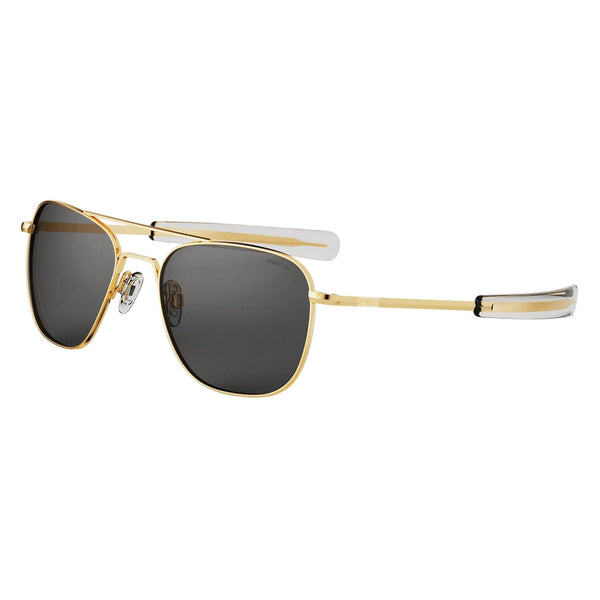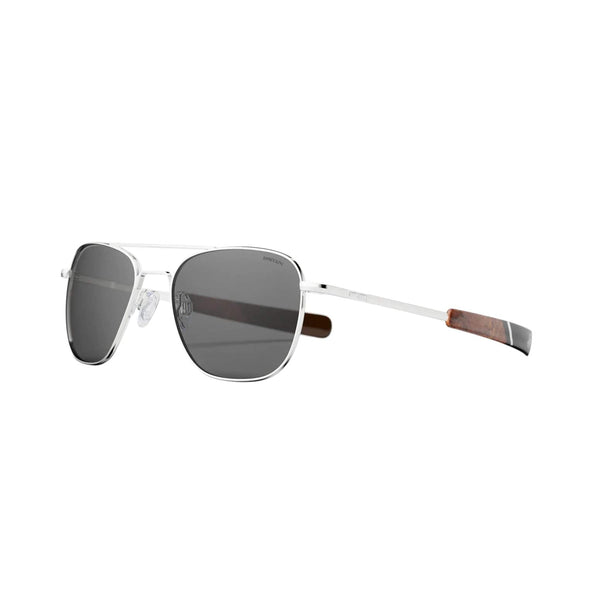Wearing sunglasses definitely looks cool, but as a pilot, it’s even more important to protect your eyes. They’re extremely valuable, and keeping them healthy is crucial for a safe, long-lasting flight career.
The type of sunglasses you wear has a direct impact on the health of your eyes, so it’s vital to choose wisely. Below, we’ll go over what to keep in mind when searching for your next perfect pair.
SUMMARY
- Full UV Protection: Choose 100% UVA/UVB coverage to guard against high-altitude rays.
- Non-Polarized Lenses: Avoid polarized lenses to prevent issues reading digital cockpit instruments.
- Snug Fit: Pick lightweight, secure frames that won’t slip under your headset.
- Tint Choice: Gray tints for bright days and brown for enhanced contrast in changing light.

Why Quality Sunglasses Matter for Pilots
As a pilot, you already know your eyes are among your greatest assets. Flying exposes you to intense sunlight—especially at altitude, where UV levels spike with every thousand feet you climb.
Protecting your eyes from this persistent exposure isn’t just about comfort and safety in-flight; it also helps prevent long-term damage to your vision.
When shopping for aviation sunglasses, ensure you get 100% UVA and UVB protection. Cockpit windshields alone don’t fully block harmful rays, so safeguard your eyes (and even the skin around them) from sun damage.
Long-term UVA & UVB Exposure
Long-term UVA/UVB exposure accelerates the aging of your eyes, boosting the risk of cataracts—a clouding of the lens that impairs your vision—and may contribute to macular degeneration, which can lead to vision loss later in life.
You might also deal with photokeratitis, which is like a sunburn on your cornea—painful and irritating. Constant UV exposure can lead to tissue growths on the eye or even skin cancers on the eyelids.
High-quality sunglasses that provide full UV coverage and use advanced lens technology are essential. Randolph Aviator Sunglasses, developed to meet stringent military specifications, deliver excellent optical performance and protection.

Best Lens Types for Pilots: Polarized vs. Non-Polarized
Polarized lenses may seem like the ideal choice for glare reduction, but in aviation, they can interfere with digital cockpit displays by filtering out light essential for reading instruments. The FAA generally advises pilots to avoid polarized sunglasses.
Non-polarized lenses maintain clarity and visibility on cockpit instruments. If you need additional glare control, consider gradient or photochromic lenses that adapt to changing light without hindering instrument readability.

Finding the Right Fit and Shape for Pilot Sunglasses
Constantly adjusting frames mid-flight is both distracting and unsafe. Aviator-style sunglasses are an excellent choice, offering wide lens coverage and a headset-friendly design.
Large lenses reduce squinting and eye fatigue on lengthy flights. Randolph’s signature lines often feature bayonet temples for a secure fit beneath headsets, ensuring comfort during turbulence.
Choose strong, corrosion-resistant materials like stainless steel or nickel silver. Randolph frames are crafted to meet rigorous military standards, delivering reliability and durability.

Tint and UV Protection: Choosing the Right Shades
Picking the right tint is about more than personal style; it can boost visual contrast and reduce eye strain. Many pilots prefer neutral gray lenses to maintain color accuracy in bright sunlight. Brown tints can sharpen contrast in overcast or hazy conditions.
Gradient lenses—darker on top, lighter at the bottom—are another option, letting you handle strong sun above the horizon while keeping the instrument panel in clearer view.
Above all, ensure your sunglasses offer 100% UVA/UVB protection. Combined with a cockpit-friendly design and non-polarized lenses, you’ll enjoy comfortable, clear vision on every flight.
Proper Care & Maintenance
Protecting your investment is just as important as choosing the right sunglasses. After all, scratched or dirty lenses can reduce clarity and compromise your visual comfort.

Frequently Asked Questions
-
What are the best aviator sunglasses for pilots?
Models like the Randolph Aviator range stand out for their exceptional durability, clarity, and UV protection, built to military standards. -
Are aviator sunglasses still in style in 2025?
Absolutely. Aviator sunglasses remain timeless and popular, especially among pilots seeking both function and fashion. -
Do aviator sunglasses look good on men?
Yes. Aviators have a universally flattering shape that suits most face types. -
What are the best budget-friendly aviator sunglasses for pilots?
While quality often comes with a higher price, Lift Aviation Tanium offers a reasonably priced, durable option suitable for cockpit use. -
Which lens material is ideal for cockpit use?
Mineral glass offers excellent clarity and scratch resistance. Nylon lenses (like Skyforce™) or polycarbonate are lightweight and strong. Choose non-polarized, 100% UV-protective lenses for the best results. -
Are photochromic lenses suitable for pilots?
They can be, but remember cockpit windows may block some UV light, preventing full darkening. Gradient or partially tinted lenses are often more consistent under rapidly changing conditions. -
Do tinted lenses affect color perception?
Yes. Gray tints maintain neutral color perception, while brown tints enhance contrast. As long as the lens isn’t too dark or distorting, either can be effective in flight.

Takeaway
Pilots face bright sunlight, glare, and complex instrument panels. Your sunglasses must be up to the task. Look for full UV protection, non-polarized lenses, and a secure fit designed for headsets. Randolph Aviator Sunglasses are a top choice, offering military-grade construction and premium lenses tailored to aviation needs.
Don’t forget proper care and maintenance to keep your lenses in pristine condition for every flight. Fly safe and protect your vision!
Interested in Stylish Gifts for Pilots?
Check out these popular guides:
- The 8 Best (Authentic) Bomber Jackets for Men in 2024
- From Cockpit to Closet: 10 Stylish Gifts for Pilots
- 20 Must-Have Christmas Gifts for Pilots [For Any Budget]
- 20 Best Aviation Watches You Can Buy Right Now [For Every Budget]
Did you find this article helpful?
Your feedback helps us improve. Let us know in the comments if there’s anything else you’d like to see covered!












